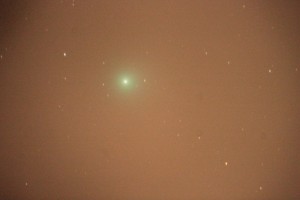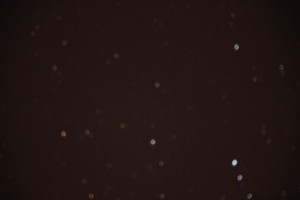So despite all my advice, you’ve gone and blown your entire paycheque on all the best lovely astrophotography toys your money could buy. You unpacked each item, lovingly holding it, admiring all the dials and knobs, before packing it up again. Eventually, a clear night, and you hastily cobble it all together and take some pictures of your favourite constellation, or perhaps dive straight into the deep end and try to capture a faint galaxy. And you’re shocked, devastated, to find that all that fancy equipment couldn’t do anything better than the examples on this page.

A comet with bad sky glow, vignetting from the optical system, and trailing from imperfect polar alignment
But before you place a classified ad to rid yourself of all this clearly faulty equipment, let me reassure you that the fault does not lie with the camera. Your picture is lousy because you messed up. You don’t yet know what you’re doing. Harsh words, I know, but astrophotography is a skill that must be learned. Nobody gets great shots all the time, and nobody gets great shots at all when they first begin. You need to learn the basics, speak to more experienced photographers, study pages like this one, and all the time keep practicing what you’ve learned. Your pictures will improve, until one day you’ll be struggling to salvage what (to your eyes) looks like a muddy mess of an image when somebody looking over your shoulder gasps and asks “Is that a Hubble picture?”. It’s even happened to me, and I’m not that good yet!
Good astrophotography technique is something of an art, because any two experiened astrophotographers can give contradictory advice on how to get the best images, yet both manage to create beautiful pictures. But there is a pretty strong consensus on the basics, and you should practice getting those right before trying to get fancy.
First of all, plan your shots. Take the time to choose in advance what you’re going to image and make sure that it’s at a convenient position in the sky – it’s frustrating to spend an evening getting your equipment set up exactly right only to find your target dipping behind a tree just as you’re about to start. Keep an eye on the weather reports, create finder charts, line up your mount as accurately as possible, ensure that all your batteries are fully charged, and make sure that you know your equipment well enough to be able to operate it in the dark.
Then, take the time to capture quality calibration images. You can decide not to bother, and still get pretty pictures, but proper pre-processing makes a huge difference to the quality of your resulting image and is well worth the time. Incidentally, it’s not necessarily best to take all calibration shots at the beginning of your observing run – dark frames are affected by temperature, so should be captured immediately before or after their corresponding light frames, for example.
Then once the stars are out, fine-tune your polar alignment – if it is not absolutely spot on perfect, your image will suffer. At best it will show a loss of contrast, at worst all your stars will be lines instead of dots, and your planets and deep sky objects will have motion blur. Good tracking is made better with the PEC function on most modern mounts, and a guidescope, but the foundation of it all is really good polar alignment.
Remember to check your focus at regular intervals – as the telescope tracks across the sky, its position change causing mechanical components to shift slightly, which affects your focus. And as the evening gets colder, mechanical components shrink slightly, affecting the focus. Fine-tuning focus is a time-consuming process that interrupts your imaging runs, but is important if you want perfect images.
Be sure to capture enough data. Don’t just grab a single frame if you can get ten. Don’t settle for 50 if you have time for 100. If the weather stays clear and your family will allow it, go out on a second (or even third) night and repeat the observation. The more data you have, the more magic you can work at processing time to reduce the noise, boost the signal, and maximise contrast, colour and detail.
And finally, and most importantly, relax! Unless you’re a paid telescope operator at a professional observatory, you’re doing this for fun. Don’t get so hung up on the perfect image that you lose out on the enjoyment of it all. Odds are that you will be sitting in front of a computer screen, ruining your night vision, but when you begin capturing a long sequence of images you’ll have nothing to do, so cover the laptop with a towel to get rid of stray light, uncap your binoculars, and enjoy the night sky while the technology does its job.

